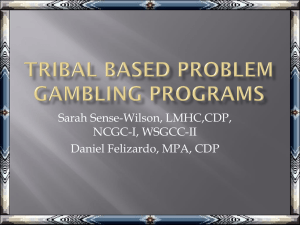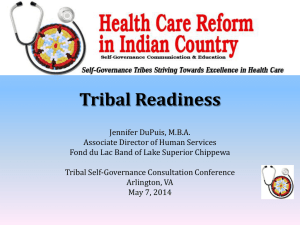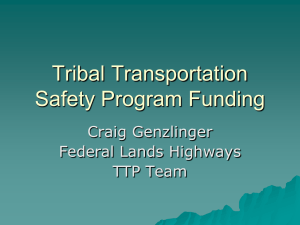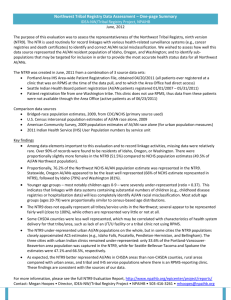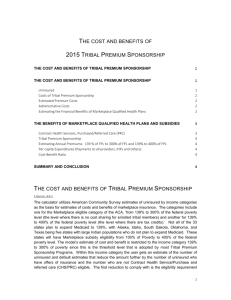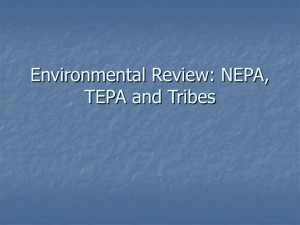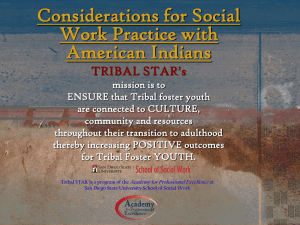Cost/Benefit Analysis of Tribal Sponsorship - Self
advertisement
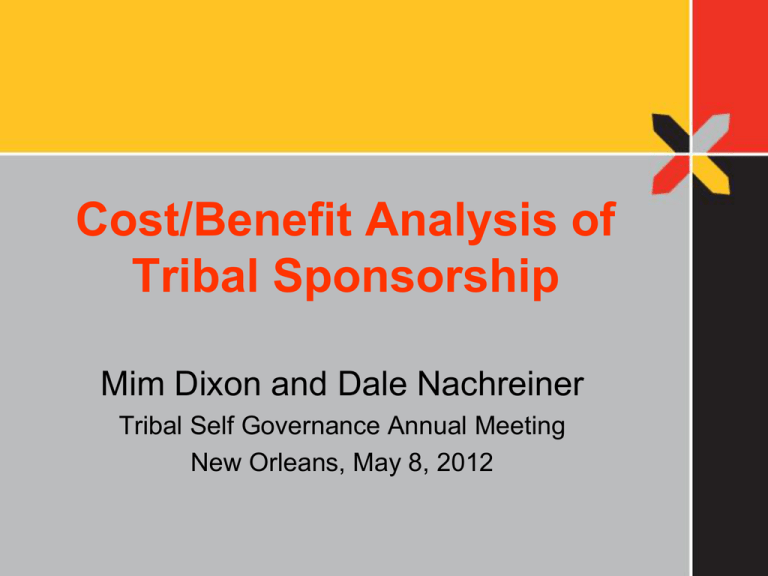
Cost/Benefit Analysis of Tribal Sponsorship Mim Dixon and Dale Nachreiner Tribal Self Governance Annual Meeting New Orleans, May 8, 2012 Opportunity in Affordable Care Act • Opportunity for Tribes • New revenues for Tribe • CHS cost savings • Tribal Sponsorship is a path to realize the revenues and savings. • New tool available to help your Tribe do cost-benefit analysis of Tribal Sponsorship. Tribal Sponsorship • Tribe pays portion of premium for selected individuals to enroll in Health Insurance Exchanges. • Federal funds can be used. • Aggregate payments • One check per month from Tribe • Payment to Exchange, Insurance or TPA • Exchange decides rules for Tribal Sponsorship. TEOC Project • Case Studies of Tribal Sponsorship • • • • 3 Tribes 2 scenarios for each Tribe Real numbers Methodology developed • Focus Group with Tribal Leaders • Cost/Benefit Analysis Tool • www.nativeexchange.org Case Study Results • Small, medium and large Tribes • 6 different scenarios • In every scenario, Tribe had net benefit Range: $65,398 to $4,684,878 • Positive rate of return Range: $1.77 to $5.99 for each $1 spent Results of Focus Group with Tribal Leaders • Health Directors are primary source of information for Tribal decisions about Tribal Sponsorship. • Tribal Councils want Health Directors to present a Tribal-specific proposal. • Health Directors must be well informed about Health Insurance Exchanges. TEOC Cost/Benefit Analysis Tool • ACA provisions guide model • Based on data and assumptions • Tribe fills out questionnaire • • • • Demographics (age) Census data (poverty levels) Billing and collection data Administrative costs • Spreadsheets calculate estimated costs and benefits of 3 scenarios. Affordable Care Act • Insurance companies can base premiums on • Age (3x greater for older people) » This is only factor used in methodology. » This is why age pyramid is needed. • Geographic area • Tobacco use (1.5% higher) • Federal subsidy of premiums • Individual payment limited to % of income » This is why income information is needed. Annual Federal Subsidy of Health Insurance Premiums by Income Level for Individuals Premium Limit as % Income % FPL Individual Premium (Tribal Sponsorship) 138-150 2% < $690 151-200 3-4% $1,037 201-250 4-6.3% $1,875 251-300 6.3-8.05% $2,776 301-400 8.05-9.5% $3,391-$4,099 Cost Assumptions • Use only people 19-64 years old <19 eligible for Medicaid or CHIP >65 eligible for Medicare • Use only individual premiums • Use Silver plan premium costs • 70 % actuarial value • Kaiser Family Foundation calculator • 138% FPL for Medicaid Expansion • Poverty rates for uninsured active users are same as AI in general population in U.S. Census Revenue Assumptions • Tribes will be providers of services for plans they sponsor. • No co-pays or deductibles for anyone sponsored by Tribe. • Reimbursement for Exchange plans will be between Medicare and commercial insurance rates. • Bill-to-collection ratio same as current commercial insurance. Calculating CHS Savings • 3 year average CHS expenditures • Use number of people eligible for CHS to get savings per person. Administrative Costs Included in Methods • Education and enrollment assistance • Provider contract administration • Billing plan for services provided Cost/Benefit Analysis Tool • Generates 1 page summary table • 3 scenarios for Tribe: • All uninsured active users • Uninsured active users eligible for CHS • Uninsured Tribal members • For each scenario: • • • • Costs Revenue and CHS savings Net benefits Estimated earnings from $1 invested Caution! • These are estimates only. • Affordable Care Act may change. • Supreme Court decision in June • Elections may affect ACA • Federal regulations are still being written • Tribe may want to consider other scenarios.




